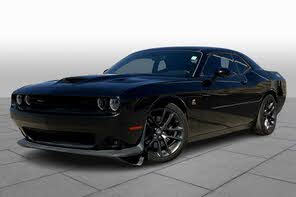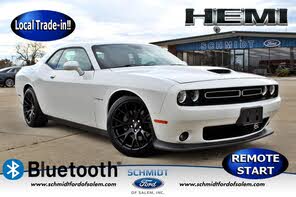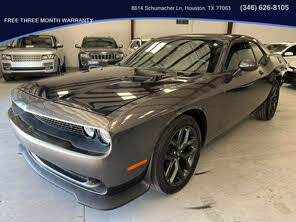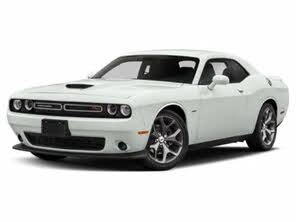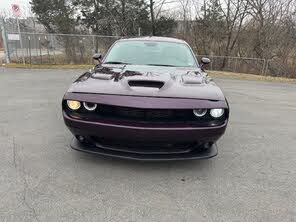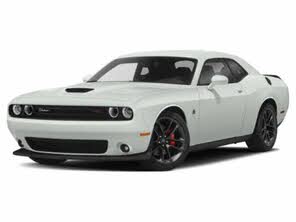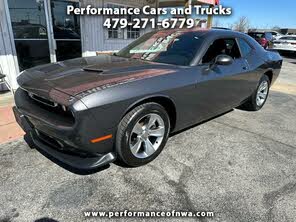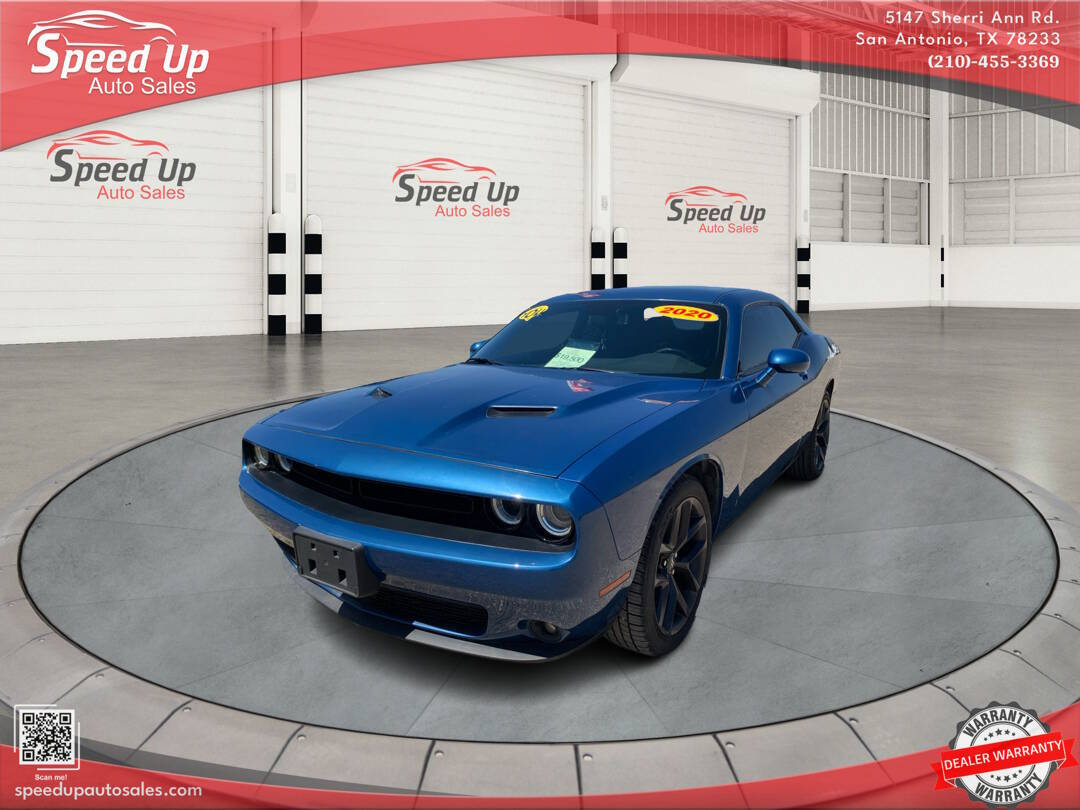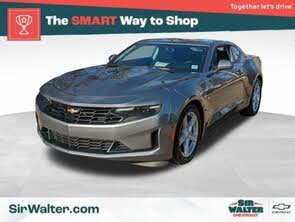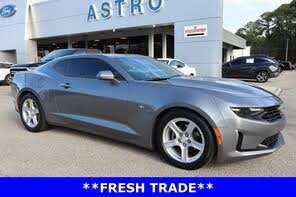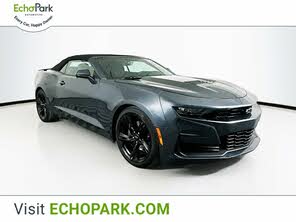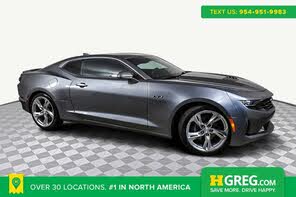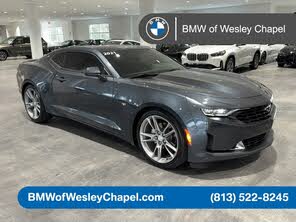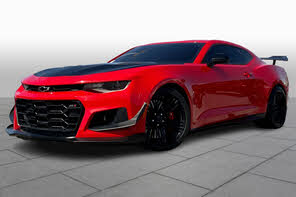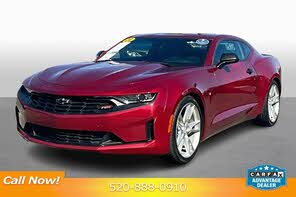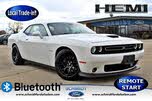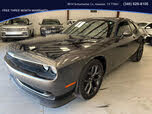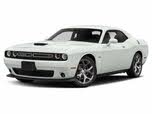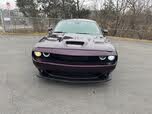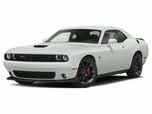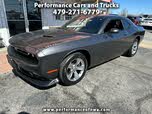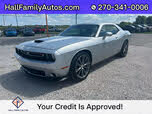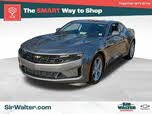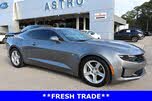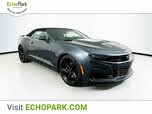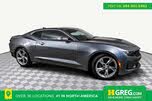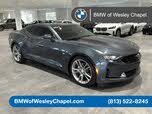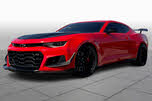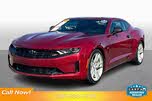2020 Dodge Challenger vs 2021 Chevrolet Camaro
Overview | |
MSRP$28,095 | MSRP$25,000 |
Average price$30,367 | Average price$33,115 |
Listings492 | Listings355 |
Ratings & Reviews | |
User Reviews | User Reviews |
Expert reviews8.0 out of 10 | Expert reviews8.0 out of 10 |
Pros
| Pros
|
2020 Dodge Challenger Reviews SummaryWith its stablemate, the Dodge Charger, the Dodge Challenger is one of the last remaining modern muscle cars. The Ford Mustang and Chevrolet Camaro have both eschewed their “retro” phases to become more forward-looking sporty coupes. But the Challenger holds fast, trading on the past while using current automotive technology to create one of the most fun-loving coupes on the market. This puts the Challenger in a field of one, but for those seeking what the Challenger has to offer, nothing else is needed. The Challenger is largely unchanged for the 2020 model year. It provides several new colors, some additional interior design choices, and adds a 50th Anniversary package for some trims. | |
2021 Chevrolet Camaro Reviews SummaryThe 2021 Chevrolet Camaro is over 3,000 pounds of pure American muscle. It’s an iconic nameplate that hasn’t received many updates for the 2021 model year, continuing to deliver the power, handling, and style buyers expect. But, that doesn’t mean that it’s perfect. | |
No video found | No video found |
Popular Features & Specs | |
Engine3.6L 303 hp V6 | Engine2.0L 275 hp I4 |
Drive TrainRWD | Drive TrainRWD |
Seating Capacity5 | Seating Capacity4 |
Horsepower303 hp @ 6350 rpm | Horsepower275 hp @ 5600 rpm |
MPG City19 | MPG City19 |
MPG Highway30 | MPG Highway29 |
Engine | |
Engine Name3.6L 303 hp V6 | Engine Name2.0L 275 hp I4 |
Torque268 lb-ft @ 4800 rpm | Torque |
Horsepower303 hp @ 6350 rpm | Horsepower275 hp @ 5600 rpm |
DrivetrainRWD | DrivetrainRWD |
Fuel Economy | |
MPG City19 | MPG City19 |
MPG Highway30 | MPG Highway29 |
Interior | |
Seating Capacity5 | Seating Capacity4 |
Safety | |
Front Crash Overall4 | Front Crash Overall4 |
Side Crash Overall5 | Side Crash Overall5 |
Dimensions & Capacity | |
Cargo Space16.2 cu ft | Cargo Space9.1 cu ft |
Curb Weight3858 lbs | Curb Weight3351 lbs |
Height57.7 in | Height53.1 in |
Length197.9 in | Length188.3 in |
Width85.4 in | Width74.7 in |
Wheelbase116.0 in | Wheelbase110.7 in |
Maximum Payload1092 lbs | Maximum Payload |
Number of doors2 | Number of doors2 |
Maximum Towing Capacity1000 lbs | Maximum Towing Capacity |
Overview | ||
MSRP | $28,095 | $25,000 |
Average price | $30,367 | $33,115 |
Listings | ||
Ratings & Reviews | ||
User reviews | ||
Expert reviews | 8.0 out of 10Read full review | 8.0 out of 10Read full review |
Pros & cons | Pros
| Pros
|
Summary | With its stablemate, the Dodge Charger, the Dodge Challenger is one of the last remaining modern muscle cars. The Ford Mustang and Chevrolet Camaro have both eschewed their “retro” phases to become more forward-looking sporty coupes. But the Challenger holds fast, trading on the past while using current automotive technology to create one of the most fun-loving coupes on the market. This puts the Challenger in a field of one, but for those seeking what the Challenger has to offer, nothing else is needed. The Challenger is largely unchanged for the 2020 model year. It provides several new colors, some additional interior design choices, and adds a 50th Anniversary package for some trims. | The 2021 Chevrolet Camaro is over 3,000 pounds of pure American muscle. It’s an iconic nameplate that hasn’t received many updates for the 2021 model year, continuing to deliver the power, handling, and style buyers expect. But, that doesn’t mean that it’s perfect. |
Video | No video found | No video found |
Popular Features & Specs | ||
Engine | 3.6L 303 hp V6 | 2.0L 275 hp I4 |
Drive Train | RWD | RWD |
Seating Capacity | 5 | 4 |
Horsepower | 303 hp @ 6350 rpm | 275 hp @ 5600 rpm |
MPG City | 19 | 19 |
MPG Highway | 30 | 29 |
Engine | ||
Engine Name | 3.6L 303 hp V6 | 2.0L 275 hp I4 |
Torque | 268 lb-ft @ 4800 rpm | |
Horsepower | 303 hp @ 6350 rpm | 275 hp @ 5600 rpm |
Drivetrain | RWD | RWD |
Fuel Economy | ||
MPG City | 19 | 19 |
MPG Highway | 30 | 29 |
Interior | ||
Seating Capacity | 5 | 4 |
Safety | ||
Front Crash Overall | 4 | 4 |
Side Crash Overall | 5 | 5 |
Dimensions & Capacity | ||
Cargo Space | 16.2 cu ft | 9.1 cu ft |
Curb Weight | 3858 lbs | 3351 lbs |
Height | 57.7 in | 53.1 in |
Length | 197.9 in | 188.3 in |
Width | 85.4 in | 74.7 in |
Wheelbase | 116.0 in | 110.7 in |
Maximum Payload | 1092 lbs | |
Number of doors | 2 | 2 |
Maximum Towing Capacity | 1000 lbs | |
The 2020 Dodge Challenger, a third-generation model, was a tribute to the 1970s classic. Updated in 2015, it retained its muscular silhouette while incorporating modern design elements like vents, wings, and scoops. The recessed headlights and grille gave it a menacing look, hinting at its performance capabilities. Inside, the Challenger featured a driver-focused cockpit with a blend of modern infotainment screens and vintage-looking bezels, though some might find the design a bit dated.
In contrast, the 2021 Chevrolet Camaro offered buyers the choice between a coupe and a convertible, both exuding a fierce look. The Camaro came in eight trim levels, with the ZL1 being the most performance-focused. Standard features included 18-inch wheels, a limited-slip differential, and LED daytime running lights. The interior, refreshed in 2019, had a stylish yet functional design, though some elements felt generic. The Camaro also offered various Wild Cherry design packs for added customization.
The 2020 Dodge Challenger's performance varied significantly across its trims. The SXT and GT trims featured a 3.6-liter V6 engine producing 305 horsepower and 268 pound-feet of torque, available with either rear-wheel drive or all-wheel drive. The R/T trim came with a 5.7-liter Hemi V8, delivering 475 hp and 410 lb-ft with a 6-speed manual, or 372 hp and 400 lb-ft with an 8-speed automatic. The R/T Scat Pack upgraded to a 6.4-liter Hemi V8, making 485 hp and 475 lb-ft. The Hellcat models boasted a supercharged 6.2-liter V8, producing 717 hp and 656 lb-ft, while the Hellcat Redeye cranked it up to 797 hp and 707 lb-ft. The Hellcat variants also featured adaptive suspension and customizable drive modes for enhanced performance.
The 2021 Chevrolet Camaro started with a turbocharged 2.0-liter four-cylinder engine, making 275 hp and 295 lb-ft of torque, paired with a six-speed manual transmission. Buyers could upgrade to a 3.6-liter V6 with 335 hp and 284 lb-ft. The Camaro also offered two V8 engines: a 6.2-liter V8 with 455 hp and 455 lb-ft, and a supercharged version delivering 650 hp and 650 lb-ft. The Camaro's manual transmission was less fuel-efficient than its automatic options, with the turbo-four manual achieving 19/29/22 mpg city/highway/combined, while the automatic got 22/30/25 mpg. The V6 manual achieved 16/26/20 mpg, and the automatic 18/29/22 mpg. The V8 engines had similar fuel efficiency, with the manual getting 16/24/19 mpg and the automatic 16/26/20 mpg. The supercharged V8 achieved 16 mpg combined regardless of the transmission.
The 2020 Dodge Challenger stood out with its spacious cabin, offering ample legroom and decent headroom for a coupe. The rear seats provided impressive legroom, though the retro styling and large rear pillars limited visibility. The Challenger boasted 16.2 cubic feet of cargo space, significantly more than the Camaro's 9.1 cubic feet. The traditional rear-wheel-drive setup resulted in a large center console, while the all-wheel-drive version had a hump in the front passenger footwell due to additional drivetrain components.
The 2021 Chevrolet Camaro came standard with cloth upholstery and front bucket seats, with options for Recaro sport seats and leather upholstery. The front seats were relatively comfortable, but the narrow windscreen and oversized hood limited visibility. The rear seats were not suitable for adults, and the trunk space, though decent for a muscle car, had a high load height and narrow opening. The Camaro's leather-wrapped, flat-bottom steering wheel felt good in the hands, and the single-zone climate control system was effective, though the design of the vents made them difficult to adjust.
The 2020 Dodge Challenger featured a standard 7-inch touchscreen infotainment system with the Uconnect interface, known for its intuitive layout. The system included Apple CarPlay and Android Auto, with an available 8.4-inch screen offering Garmin-based navigation. Higher trims like the R/T Scat Pack, Hellcat, and Hellcat Redeye included an Alpine premium stereo system. The Challenger also had a digital display in the instrument panel, controlled by large directional pad buttons on the steering wheel.
The 2021 Chevrolet Camaro came with a 7-inch infotainment touchscreen, Bluetooth, voice command, wireless Apple CarPlay, wireless Android Auto, a six-speaker audio system, 4G LTE WiFi hot spot, and keyless entry and start. Available features included a head-up display, navigation, Bose premium audio system, satellite radio, an 8-inch infotainment touchscreen, wireless charging, and a rear-camera mirror. The driver-information center and infotainment touchscreen were functional but suffered from a forward lean that caused glare.
The 2020 Dodge Challenger came standard with front- and side-impact airbags, supplemental side curtain airbags, traction control, brake assist, and a child-seat anchoring system. Optional safety features included forward collision warning, adaptive cruise control, blind-spot monitoring, rear cross-path alert, and the ParkSense reverse sensing system. The Challenger earned four out of five stars in front driver’s side crash testing by the National Highway Traffic Safety Administration (NHTSA), five stars for front passenger side testing, and four stars for rollover testing. It received a "Good" rating in many phases of Insurance Institute for Highway Safety (IIHS) crash tests but earned a "Marginal" overall score.
The 2021 Chevrolet Camaro had mixed safety ratings, with the Insurance Institute for Highway Safety (IIHS) giving it "Good," "Acceptable," and "Basic" ratings, while the National Highway Traffic Safety Administration (NHTSA) awarded it five-star and four-star ratings. Available safety features included rear cross-traffic alert, blind-spot monitoring, forward-collision warning, lane-change alert, and rear parking sensors. Some safety technology was not available on Camaro convertible models.
CarGurus highlights

According to CarGurus experts, the overall rating for the 2020 Dodge Challenger is 8.0 out of 10, while the 2021 Chevrolet Camaro scores 8.0 out of 10. Both cars offer unique strengths, but the Challenger's spacious interior and user-friendly technology make it a more practical choice for everyday use.
Choose the 2020 Dodge Challenger if:
- You need a spacious cabin with ample rear-seat legroom and cargo space.
- You prefer a retro-styled muscle car with modern performance options.
- You value a user-friendly infotainment system with intuitive controls.
Choose the 2021 Chevrolet Camaro if:
- You want a choice between coupe and convertible body styles.
- You prefer a variety of engine options, including a powerful supercharged V8.
- You appreciate modern technology features like wireless Apple CarPlay and Android Auto.
CarGurus highlights

According to CarGurus experts, the overall rating for the 2020 Dodge Challenger is 8.0 out of 10, while the 2021 Chevrolet Camaro scores 8.0 out of 10. Both cars offer unique strengths, but the Challenger's spacious interior and user-friendly technology make it a more practical choice for everyday use.
Choose the 2020 Dodge Challenger if:
Shop Now- You need a spacious cabin with ample rear-seat legroom and cargo space.
- You prefer a retro-styled muscle car with modern performance options.
- You value a user-friendly infotainment system with intuitive controls.
Choose the 2021 Chevrolet Camaro if:
Shop Now- You want a choice between coupe and convertible body styles.
- You prefer a variety of engine options, including a powerful supercharged V8.
- You appreciate modern technology features like wireless Apple CarPlay and Android Auto.

By: CarGurus + AI
At CarGurus, our team of experienced automotive writers remain at the heart of our content operation, conducting hands-on car tests and writing insightful guides that are backed by years of industry experience. To complement this, we are harnessing AI to make our content offering more diverse and more helpful to shoppers than ever. To achieve this, our AI systems are based exclusively on CarGurus content, ratings and data, so that what we produce is both unique to CarGurus, and uniquely helpful to car shoppers.











